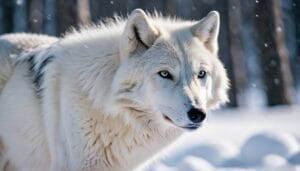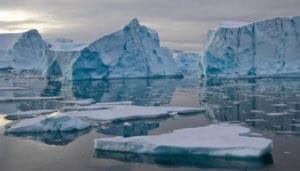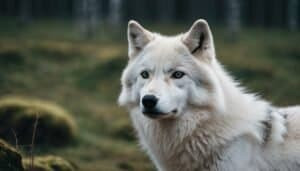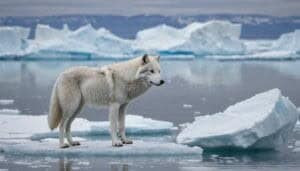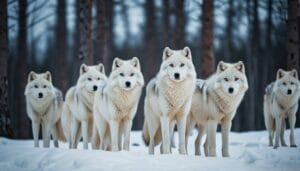Introduction
The behavior of Arctic wolves is significantly influenced by the extreme seasonal variations in daylight experienced in their habitat. These changes range from continuous daylight in summer to extended periods of darkness in winter, prompting a range of adaptive behaviors
This article delves into the seasonal adaptations of Arctic wolves, the impact of winter darkness on their activities, and the role of circadian rhythms and social dynamics in their behavior
Seasonal Adaptations in Arctic Wolf Behavior
Arctic wolves, or Canis lupus arctos, are uniquely adapted to the extreme conditions of the Arctic, where seasonal variations in daylight dramatically impact their behavior. These adaptations are critical for their survival, influencing their hunting patterns, energy management strategies, and social behaviors
Changes in Hunting Patterns
During the Arctic summer, the sun never sets, providing 24 hours of daylight. This continuous light allows Arctic wolves to hunt at any time, but it also requires them to adjust their typical hunting strategies
Prey, such as caribou and muskoxen, are more active and scattered during the constant daylight, necessitating that wolves cover larger territories to find food. This period of continuous activity increases the wolves’ chances of encountering prey, but also demands more energy and endurance
Conversely, the winter months bring extended periods of darkness, significantly altering hunting dynamics. The prolonged darkness reduces visibility, making it more challenging for wolves to locate prey
To cope with this, Arctic wolves may rely more on their acute senses of hearing and smell. They also tend to hunt in packs more frequently during winter, as cooperation increases the likelihood of a successful hunt in low-light conditions. Hunting strategies become more calculated and deliberate, often involving ambush techniques that take advantage of the cover of darkness
Energy Management Strategies
Managing energy efficiently is crucial for Arctic wolves, especially given the harsh and fluctuating environmental conditions
In the summer, with abundant prey and long days, wolves can afford to be more active, expending significant energy in hunting and territorial patrols. Their metabolic rates increase to match the higher activity levels and the need to cover extensive areas in search of food
In winter, the scarcity of prey and the extended darkness force wolves to adopt more conservative energy management strategies. They become less active, minimizing unnecessary movement to conserve energy
Fat reserves accumulated during the summer and fall become vital during this time, providing the necessary fuel for survival when hunting opportunities are scarce. Additionally, the wolves’ thick fur and social huddling help reduce heat loss, further conserving energy
Social Behavior Adjustments
Arctic wolves’ social structures and behaviors are also influenced by the seasonal changes in daylight
In the continuous daylight of summer, pack dynamics can be more fluid as wolves take advantage of the extended hours to engage in social activities, such as playing, grooming, and bonding. The longer days provide more opportunities for the wolves to strengthen their social bonds, which are crucial for cooperative hunting and raising pups
During the winter, the pack’s social behavior becomes more focused on survival. The wolves spend more time resting and conserving energy, with social interactions being more functional and less playful
The extended darkness and harsh conditions reinforce the importance of pack cohesion, as wolves rely heavily on each other for warmth and support during hunting. Communication becomes more critical, with vocalizations and body language playing a key role in coordinating activities and maintaining social order within the pack
Impact of Winter Darkness on Behavior
Winter in the Arctic brings prolonged periods of darkness, significantly impacting the behavior and survival strategies of Arctic wolves. These adaptations are crucial for coping with the harsh and challenging environment during this time
Impact on Breeding
The breeding cycle of Arctic wolves is closely tied to the seasonal changes in daylight. Mating typically occurs in late winter, around February and March, when the days start to lengthen slightly
This timing ensures that the pups are born in late spring or early summer, when conditions are more favorable and food is more abundant. The extended darkness of winter leads to a decrease in overall activity, which allows the wolves to conserve energy and focus on finding mates and preparing for the upcoming breeding season
During this period, pack cohesion becomes especially important. The alpha pair, typically the only breeding pair in a pack, will establish strong bonds to ensure the successful raising of pups. The other pack members support the alpha pair by helping to protect and provide for the pups once they are born
This cooperative breeding strategy is essential for the survival of the young in the harsh Arctic environment
Shifts in Hunting and Feeding
The prolonged darkness of winter necessitates significant shifts in hunting and feeding behavior. With reduced visibility, Arctic wolves rely more heavily on their senses of smell and hearing to locate prey. This period is marked by a decrease in prey activity, as animals like caribou and muskoxen also adapt to the harsh conditions by moving less and conserving energy
Arctic wolves adjust their hunting strategies to these conditions by becoming more opportunistic. They may scavenge more frequently, taking advantage of any available food sources, including carcasses left by other predators or those that have succumbed to the cold
Pack hunting becomes more prevalent, as cooperation increases the chances of a successful hunt in the difficult winter conditions. The wolves’ ability to work together and communicate effectively is critical during this time, as it allows them to coordinate their efforts and improve their hunting success rate
Energy Conservation Methods
Energy conservation is paramount during the extended darkness of the Arctic winter. The scarcity of food and the need to maintain body heat in sub-zero temperatures require Arctic wolves to adopt various strategies to conserve energy
They reduce their overall activity levels, resting for long periods to minimize energy expenditure. When they do move, they do so deliberately and efficiently, often traveling in a single file to conserve energy and create a path through the snow
Wolves also rely on their thick winter coats, which provide excellent insulation against the cold. Additionally, pack members huddle together for warmth, sharing body heat to reduce individual energy loss. This behavior not only helps to keep them warm but also reinforces social bonds within the pack, which are essential for their survival
Furthermore, Arctic wolves build dens or find natural shelters to protect themselves from the extreme cold and wind. These shelters help to maintain a more stable microclimate, reducing the amount of energy required to stay warm
During the harshest conditions, wolves may stay in their dens for extended periods, venturing out only when necessary to hunt or scavenge
Role of Circadian Rhythm and Social Dynamics
Circadian rhythms and social dynamics play crucial roles in the behavior of Arctic wolves, especially in the context of the extreme seasonal changes in daylight
These factors help the wolves to adapt their daily and seasonal activities, ensuring survival and effective pack functioning
Role of Circadian Rhythm in Behavior
Circadian rhythms are the internal biological clocks that regulate the daily cycles of activity and rest in animals
For Arctic wolves, these rhythms are significantly influenced by the extreme variations in daylight between summer and winter. During the summer, with continuous daylight, the circadian rhythm of Arctic wolves becomes less pronounced. They exhibit more flexibility in their activity patterns, often hunting and traveling at any time of day or night
This adaptability is essential for maximizing the extended period of prey availability and ensuring that they can take advantage of the abundant resources during the brief Arctic summer
In contrast, the prolonged darkness of the Arctic winter strengthens the circadian rhythm, with wolves tending to be more active during the limited daylight hours and resting during the darkest periods. This adjustment helps them conserve energy and maintain body temperature, as moving during the coldest, darkest times would require more energy
The synchronization of activity periods with the scarce daylight helps the wolves optimize their hunting efficiency and reduces the risks associated with nocturnal activities in extreme cold
Social Dynamics and Group Coordination
Social dynamics within a wolf pack are critical for survival, especially in the challenging Arctic environment
The extended daylight in summer and the prolonged darkness in winter both necessitate strong social cohesion and coordination among pack members. In the summer, the abundance of light and food resources allows for more social interactions, such as playing, grooming, and bonding. These activities strengthen the social bonds within the pack, which are vital for cooperative hunting and raising pups
During the winter, social dynamics become even more crucial. The harsh conditions and scarcity of food require the wolves to work together more closely. Pack members must coordinate their activities, such as hunting and traveling, to maximize efficiency and success
Effective communication is essential for this coordination, with wolves using vocalizations, body language, and scent markings to convey information and maintain social order. The alpha pair plays a central role in leading and organizing the pack, ensuring that all members work together harmoniously
Communication Methods in Different Light Conditions
Communication among Arctic wolves adapts to the changing light conditions throughout the year. In the summer, the continuous daylight allows for more visual signals and body language to be used in communication
Wolves can see each other’s movements and postures clearly, which helps them convey messages related to hunting, social interactions, and pack hierarchy
In the winter, with extended periods of darkness, vocal communication becomes more important. Howls, barks, and other vocalizations are used to maintain contact between pack members, coordinate hunting efforts, and establish territory boundaries
These vocal signals can travel long distances, making them effective in the open Arctic landscape where visibility is limited. Scent marking also plays a significant role in communication, with wolves using their urine and feces to mark territory and convey information about their presence and status to other pack members and rival packs
Conclusion
Arctic wolves exhibit remarkable adaptations to cope with the extreme seasonal variations in daylight in their habitat. These changes, from continuous summer daylight to prolonged winter darkness, significantly influence their behavior and survival strategies
During the summer, the wolves take advantage of the extended daylight by adjusting their hunting patterns, managing energy efficiently, and engaging in social behaviors that strengthen pack cohesion. In the winter, the extended darkness impacts their breeding cycles, necessitates shifts in hunting and feeding strategies, and requires stringent energy conservation methods
The wolves’ circadian rhythms and social dynamics are finely tuned to these seasonal variations, ensuring they can effectively navigate the challenges of their environment. The interplay between circadian rhythms, social coordination, and communication methods helps Arctic wolves thrive despite the extreme conditions of their Arctic home



